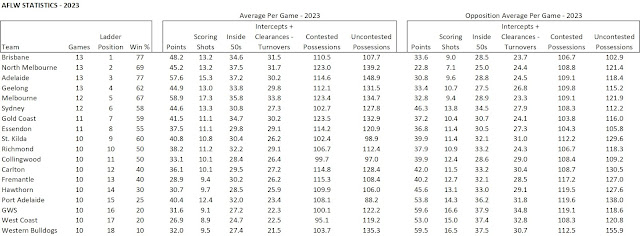The
Brisbane Lions have won their second AFLW premiership (from their fifth Grand
Final), and despite finishing fourth after the home-and-away season, it wasn’t
much of a surprise. The top four teams – Adelaide, Melbourne, North Melbourne,
and Brisbane – were all rated similarly heading into the finals, and in line
with this we saw a few close finishes in games during the finals series. There
were some surprises along the way though.
First,
Brisbane kicked seven goals in the Grand Final against North Melbourne from
only 21 entries inside 50. The Roos’ defence had been stellar during the 2023
season, conceding less than four goals per game, and being the only team to
concede less points per game than inside 50s (see Statistics table above). The
Lions were seemingly well-beaten in the midfield, with 13 less inside 50s and
18 less clearances. But they found ways to stop the repeated entries into their
defence, amassing 109 tackles (over 30 more than the Roos, and the Lions’
season average), and to score from their limited opportunities going forward.
In the
end the Lions don’t quite finish the season as the top team on the rankings,
but they are certainly one of the best teams in the competition. Like Adelaide
and North Melbourne – and Melbourne until recently, more on which below – they
were clearly stronger across the board than most of the league. A few
unexpected losses to lower teams meant they had to do it a slightly harder way
in the finals by beating Adelaide and North Melbourne away, but there would not
have been many who thought they didn’t have the credentials to give it a good
shake at least.
The main surprises of the finals series though were the significant changes in form of Melbourne and Geelong. Reigning premiers Melbourne had been a scoring machine during the 2023 season but could manage only nine points in their first final against North Melbourne. The Demons then faced Geelong the next week and kicked only one goal and trailed by 30 points at three quarter-time. They finally recaptured their offensive power in the final quarter by piling on five goals, but ultimately lost by five points.
After knocking off the reigning premiers, Geelong continued their impressive form by coming close to beating Brisbane at home. They lost by only four points, although like Brisbane in the Grand Final, they were helped by their scoring efficiency when inside 50. The end result is that Melbourne slipped away from Brisbane, North, and Adelaide in the rankings, and were replaced in the top four by the Cats. While it’s a little strange to see Melbourne end up there after being so dominant during the season, based on their finals form it’s hard to argue.

